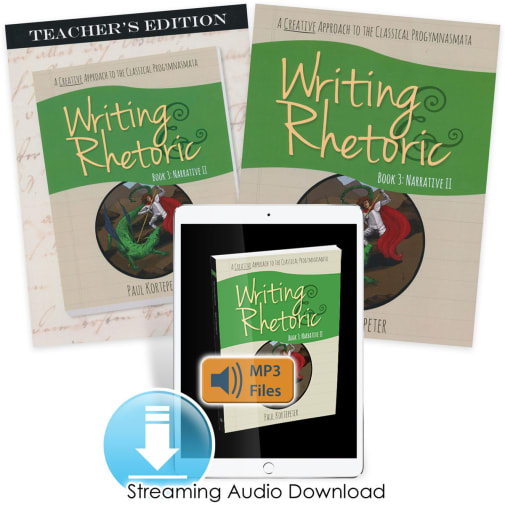A one-stop shop! This package includes everything needed (student and teacher book) to complete Writing & Rhetoric Book 3: Narrative 2, a one-semester course, PLUS the optional Audio Files featuring the reading of the fables, narratives, legends, myths, and other excerpts presented in the student book. The MP3 audio files add flexibility and can enhance understanding, allowing students to listen or follow along with text, but please note that teacher interaction and discussion is still needed. Upon purchase, the access code and instructions for MP3 files will be emailed to you. The included Student Text (059115) is consumable, so if you have 2 students you will need to purchase another. The included Teacher Edition (059116) is intended to be used in conjunction with the student book and includes a copy of student material with teaching notes, explanations, answer keys, helpful guidance and examples for every assignment. ~Nancie
Writing & Rhetoric Book 3: Narrative II Package
Description
A one-semester course for grades 4 or 5 and up In the award-winning Writing & Rhetoric series, author Paul Kortepeter has thoughtfully and creatively recovered the proven method of the progymnasmata, a step-by-step apprenticeship in the art of writing and rhetoric. Writing & Rhetoric Book 3: Narrative II (Student Edition) is the third title in this 12-book series.
Full program includes:
Writing & Rhetoric Book 3: Narrative II (consumable student edition) This book exposes students to new genres of story, including historical narrative and legend. It includes a variety of culturally important examples. All of the skills practiced in Narrative I are extended and new skill sets are introduced, including identifying the difference between fact and opinion and learning to ask the five W's of a historical narrative: who, what, when, where, why. Lessons include:
* How to define and identify types of narrative
* How to outline stories
* How to get a story off the ground
* How the protagonist and antagonist develop the central story conflict
* How to discern the difference between fact and opinion in historical narrative and legend
* How to identify the five W’s of an historical narrative—who, what, when, where, why
* How to summarize a longer narrative in writing
* Rewriting: what happens when you change the point of view and the protagonist
* How to apply storytelling skills
* Elocution skills and oration
* Writing & Rhetoric Book 3: Narrative II Teacher’s Edition: This teacher’s edition includes the complete student text, as well as answer keys, teacher's notes, and explanations. For every writing assignment, this edition also supplies descriptions and examples of what excellent student writing should look like, providing the teacher with meaningful and concrete guidance.
Includes 11 lessons utilizing fables, historical narratives and legends. Builds on previous skills and covers fact vs. opinion, using the five W's and creating characters.
| Product Format: | Product Bundle |
|---|---|
| Grades: | 4-6 |
| Brand: | Rainbow Resource Center |

